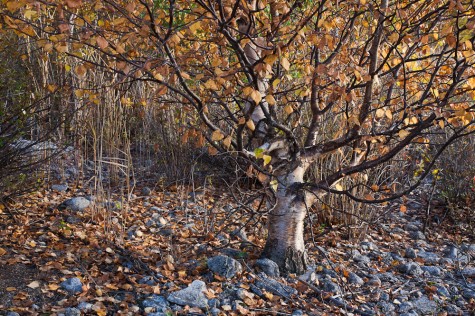 Paper Birch along rocky Ministik shoreline It is unusual to find exposed rock along the shores of the lakes in this part of Alberta, but this beautiful shoreline along Oliver Lake in the Ministik Game Bird Sanctuary just east of Edmonton had several hundred meters of this gorgeous blue-grey stone typical of the Beaver Hills/Cooking Lake moraine landform. Tall reeds and grasses, all dried up by this time, grew from between the stones and above the high water mark there were aspen, birch, and spruce. And then there was this tree—growing near the water in a little clearing.
My timing was just right—all the tree’s leaves had turned to this reddish yellow, with a few fallen to the ground to contrast the colour of the rocks (the next few days were quite windy, stripping most of these leaves for the season). When I first arrived at this spot, the sun was reasonably low in the sky, but the white bark of the birch tree was still reflecting too much light and the contrast was more than my camera could capture. Sometimes, bracketing exposures and combining them to an HDR image for processing can reign in such high-contrast scenes, but in this case a slight breeze was rustling the leaves and grass stems, which makes it very difficult to blend multiple exposures successfully.
Looking to the west however, I noticed that a bank of high stratus clouds rose a few degrees above the horizon in the otherwise perfectly clear sky. Normally, this is bad news if you’re trying to photograph dramatic late-day sidelighting and sunset colours (which I was trying to do). In this case though, I waited until the sun had just dipped behind the thin leading edge of the clouds, causing the light to dim a little and to diffuse ever so slightly—reducing the contrast in the scene, but still lighting the brilliant fall colours. I hurried to capture a few compositions that I’d determined while waiting for the light, and far too quickly—the light was gone. I walked back to the truck as the lacklustre sky simply grew darker with the sun hidden behind the advancing clouds—but I couldn’t possibly have been any happier.
 Golden autumn aspen shoreline If you’re in the Edmonton area, and haven’t been out enjoying (and photographing) the fall colours this week, I have one word for you—go! I’ll let this photograph speak the thousand words’ encouragement.
I’ve been exploring the south-west corner of Ministik Lake Sanctuary, following game trails along the shore of Oliver Lake and coming across views like this one. This is one of my favourite autumn combinations—yellow aspen & birch, bright dried grasses, all against a blue sky reflected in a still lake, and with just a few dark spruce thrown in for accent. Gorgeous.
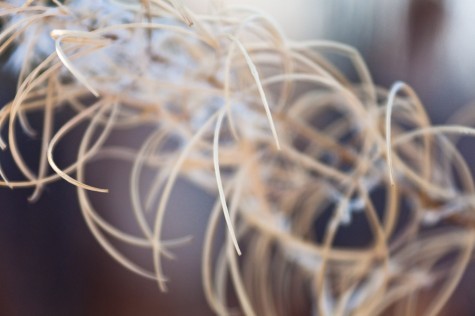 Curves in dried fireweed I know it’s odd to call this post “Dried fireweed detail” when 95% of the photograph is out of focus. For me however, this image captures the essence of the detail—and the depth—of the dried seed pods. The title’s also a bit if a play on words—using “detail” in the sense of a close-up of a portion of a larger work, like when a small section of a painting is enlarged in a book to show a painter’s technique, for example. I really enjoy getting in close to a photographic subject to look for an angle that can capture the greater “whole” of the subject while showing only a small portion.
 Warm winter colours I took this photograph during a beautiful lunch-time walk through the Whitemud Ravine. Although it was mid-day, because of the season the light was angled low and filtered through a very light haze, giving it a warm tone. It’s unusual to see warm-toned colours much during the winter, but if you catch it just right they can add an interesting mood to an image.
Several of my favourite Alberta landscape photographers have been posting small galleries of their past year’s best landscape photographs, so I decided to do the same. It was fun to look back through a year’s worth of photos, and impossible to decide which were my “favourite”. I decided to pick one favourite photo from each of the locations in Alberta that I regularly make photographs including: Jasper National Park, Waterton National Park, and the Icefields Parkway in the Rocky Mountains; and Ministik Lake Game Bird Sanctuary, Whitemud Ravine, Gold Bar Park, and the Strathcona Science Park closer to my home in Edmonton.
I’ve posted all of the photos below as a group (in chronological order) but I will also create a separate entry for each photo to provide extra details about the image like I usually do—just click on the link below each photo to go to it’s detail page. (It will take me a little while to get them all up)
I hope you enjoy this small collection, and I do always appreciate it if you leave a comment with your thoughts or reaction. Happy New Year, and I wish you many fine photographs in 2010!
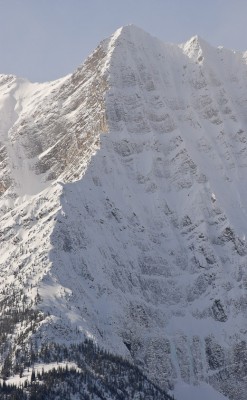 Mountain Geraldine ridge Along the Icefields Parkway [ Click for more details]
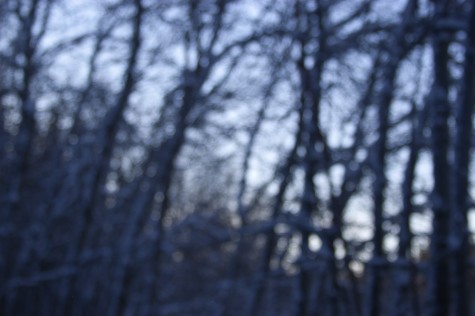 Pale winter sky through poplar canopy Ministik Lake (in the winter)
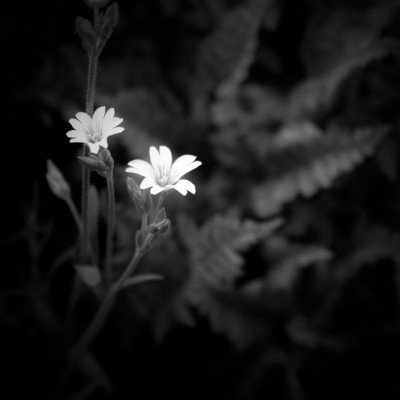 Chickweed blooms and fern Waterton National Park
 Brooding cloud over Ministik Lake Ministik Lake (in the summer) (I know that’s cheating a little)
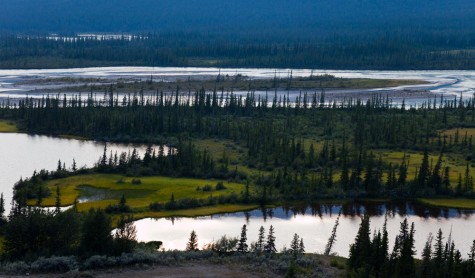 Athabasca River island at dusk Jasper National Park
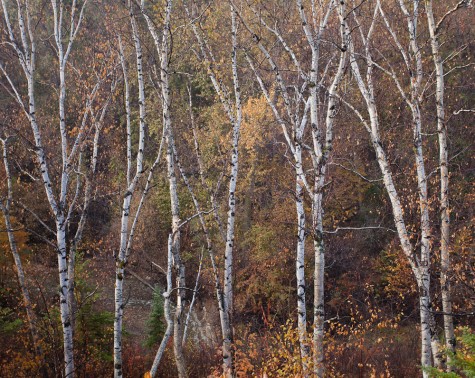 Birch stems and early autumn colour Goldbar Park (North Saskatchewan River Valley)
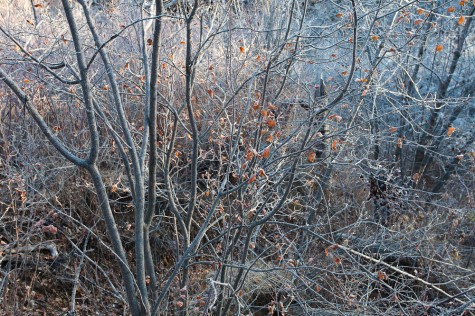 Late autumn willow thicket Whitemud Ravine [ Click for more details]
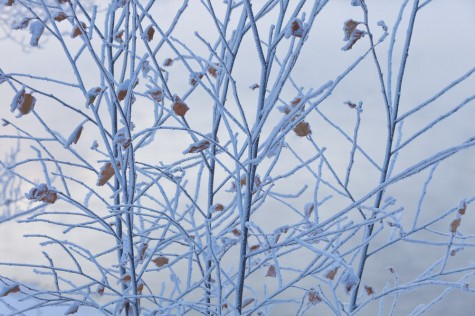 Ice fog frozen on alder saplings Strathcona Science Park [ Click for more details]
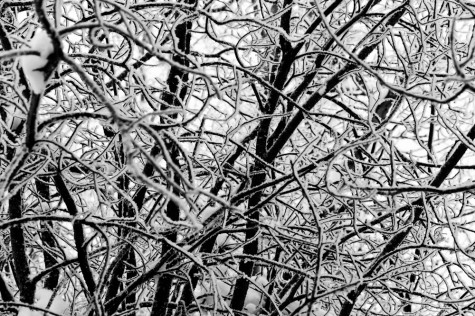 Tangle of winter branches II Here’s another detail-oriented image taken during our recent spell of grey, overcast winter days. As I mentioned in a previous post, when the light is diffused so evenly by the low, bright stratus clouds that are common over central Alberta in the winter (especially the past few weeks), it’s often these close-up, detail oriented compositions that I find work best.
I don’t commonly convert images to black and white, and even less often do I process them quite as heavily as I have here. While the contrast was fairly strong to begin with, I’ve “crushed” the darks all the way down, and bumped the background sky all the way up, to really emphasize the somewhat abstract pattern of the tangled branches, accentuated by the lining of snow and frost. Perhaps I’ll also post the original version as well, and I would love to hear your comments as to which you prefer.
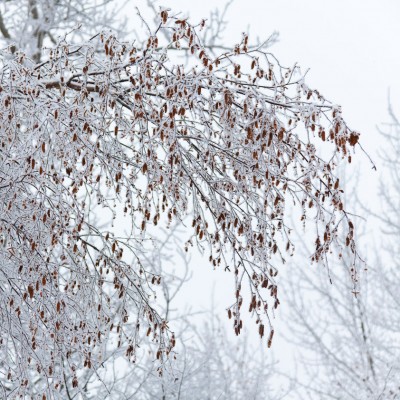 Branches and catkins against a flat winter sky In central Alberta the cold snap is over, and a prolonged case of the “winter-stratus” has set in—stratus clouds, that is. These are low, featureless clouds and in winter, when there isn’t much moisture, they are generally light grey to nearly white. Sometimes, like yesterday afternoon, they’ll lift a little to where you might call them altostratus, and you’re more likely to catch a little break for the sun to peak through. These are probably the most common clouds (stratus and altostratus) over Edmonton during the winter when there’s not enough solar energy to build a decent cumulus cloud. (I think I may be letting the cloud-watcher nerd in me show a little here).
Photographically speaking, stratus clouds make the light perfectly flat and even, which can be both a curse and a blessing. Generally, the contrast of side light and shadows makes for more dramatic images than the flat light under a stratus ceiling, but I find that sometimes detail-oriented compositions benefit from the “huge softbox in the sky” effect. I enjoy the challenge of finding these photographs on days that would normally be considered photographic busts.
|
(Click photos to enlarge)
|















